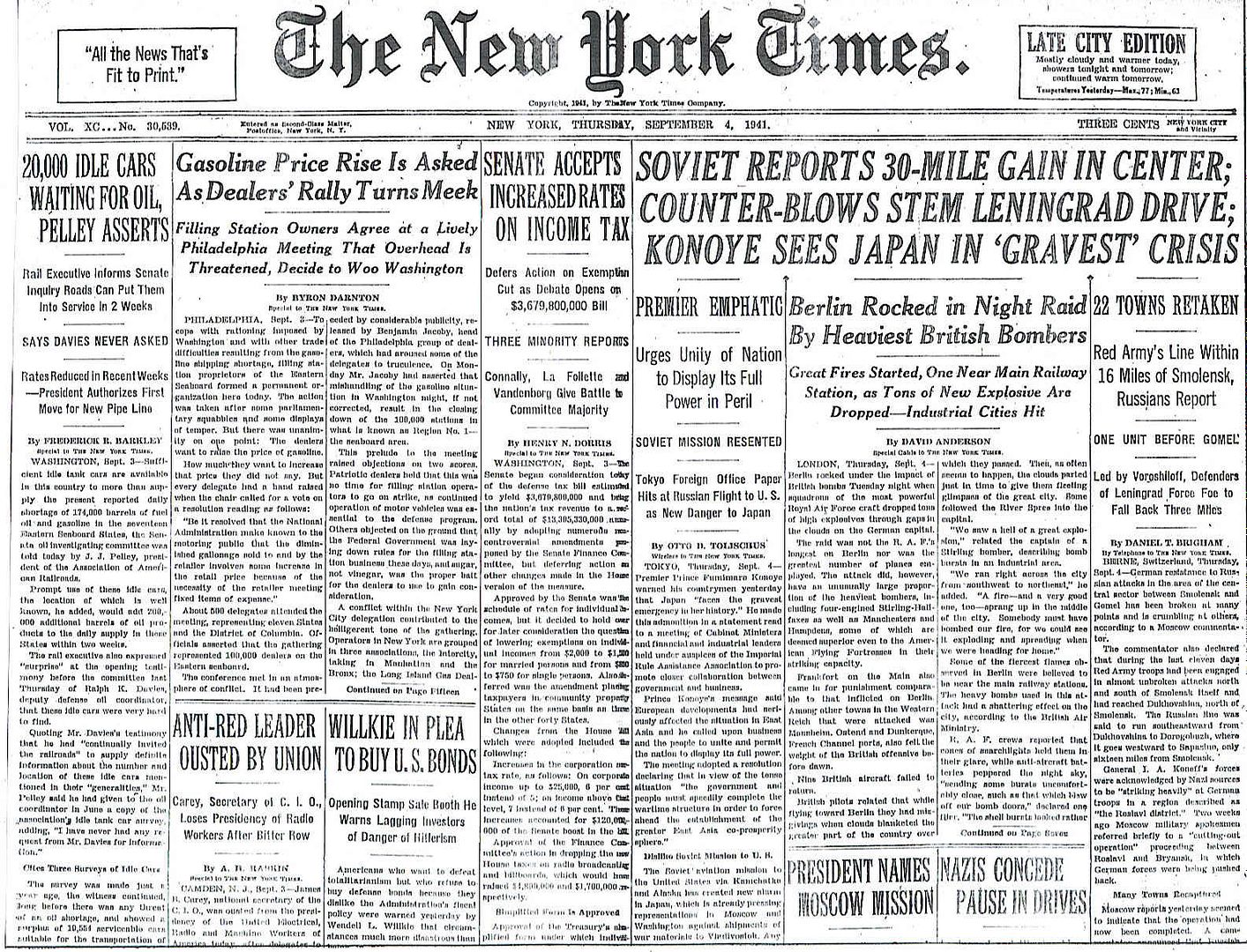
Posted on 09/04/2011 5:22:32 AM PDT by Homer_J_Simpson

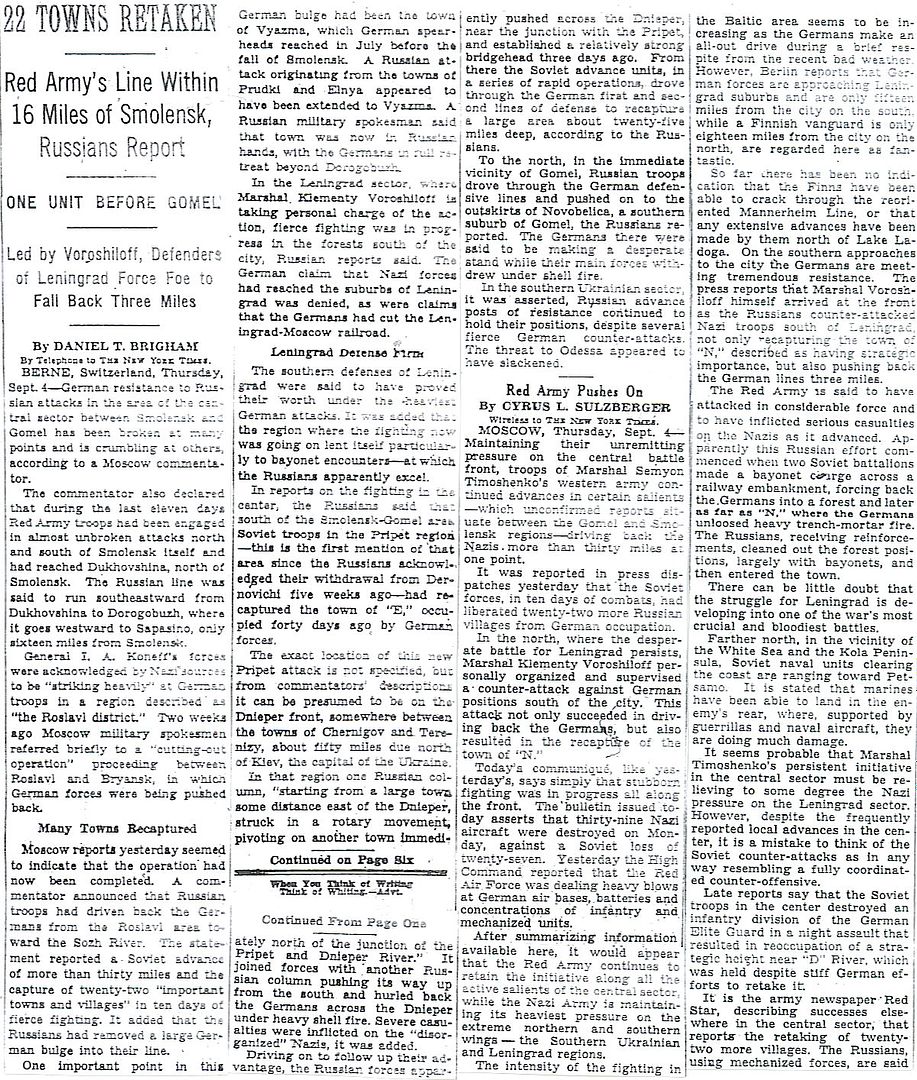
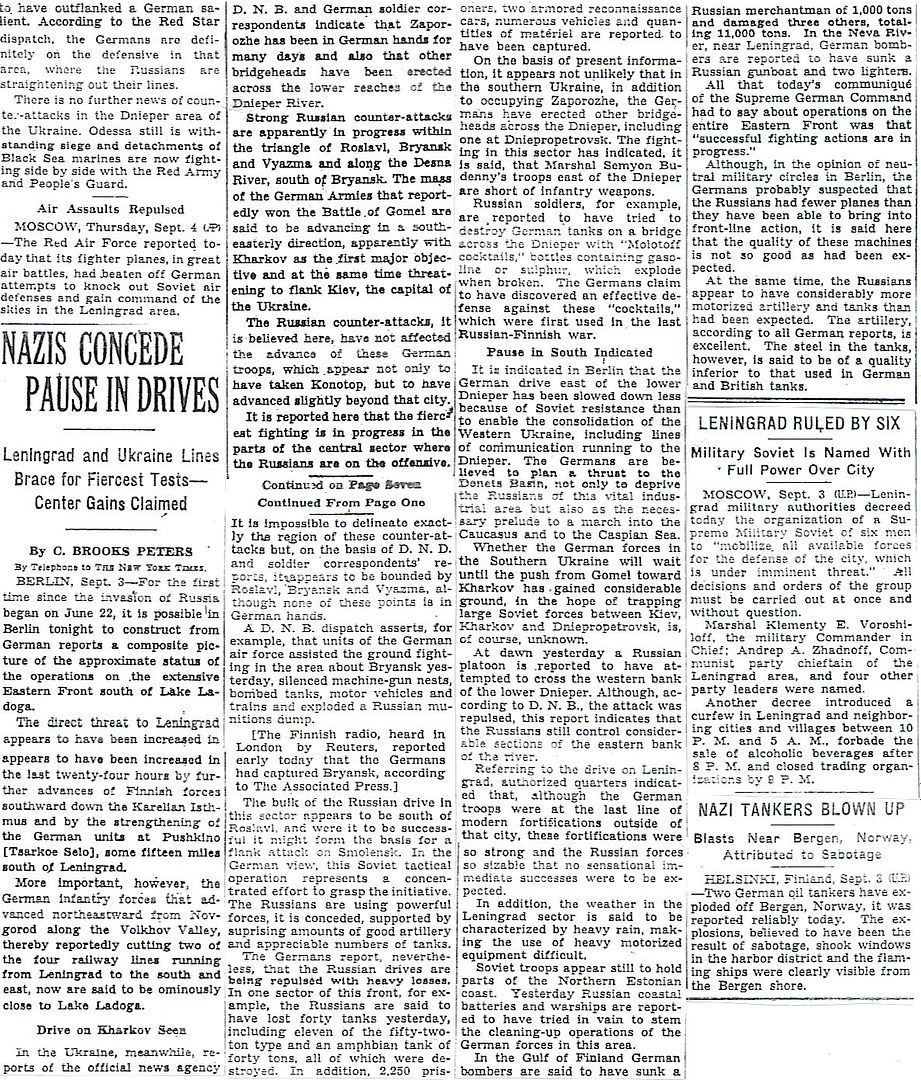
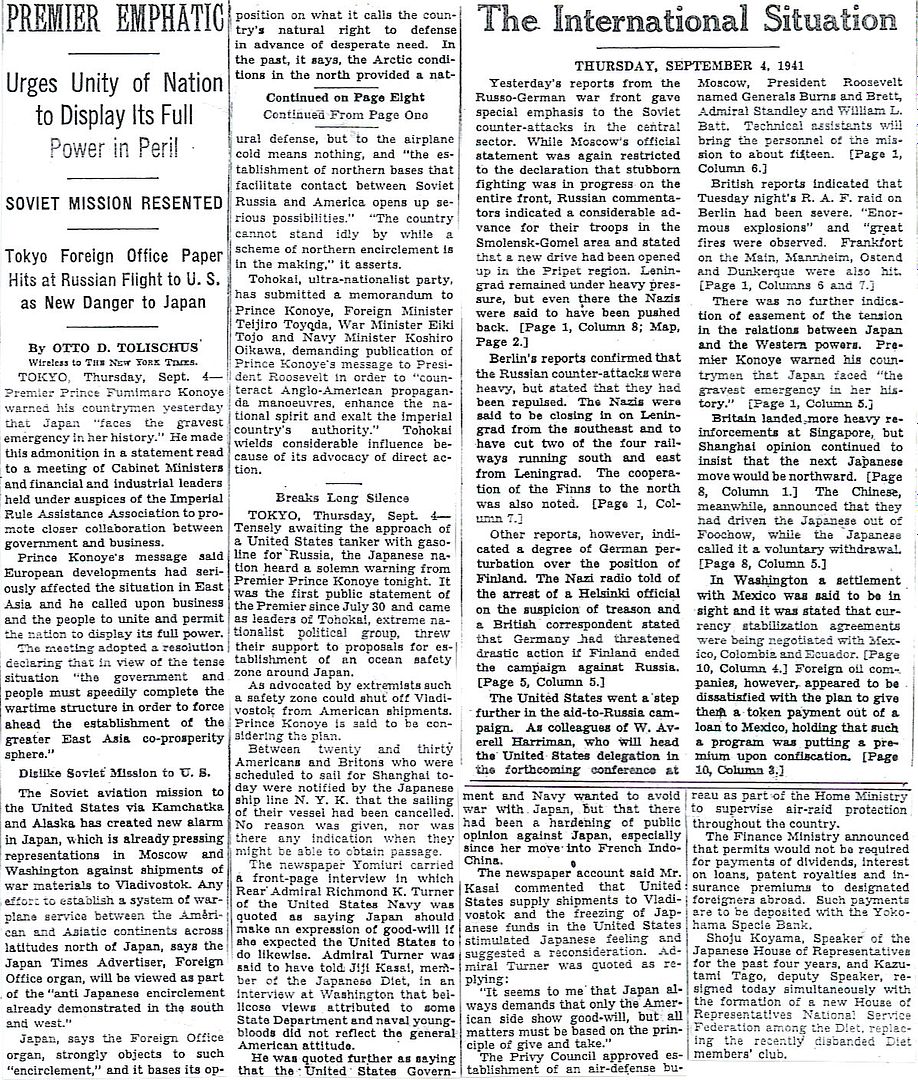
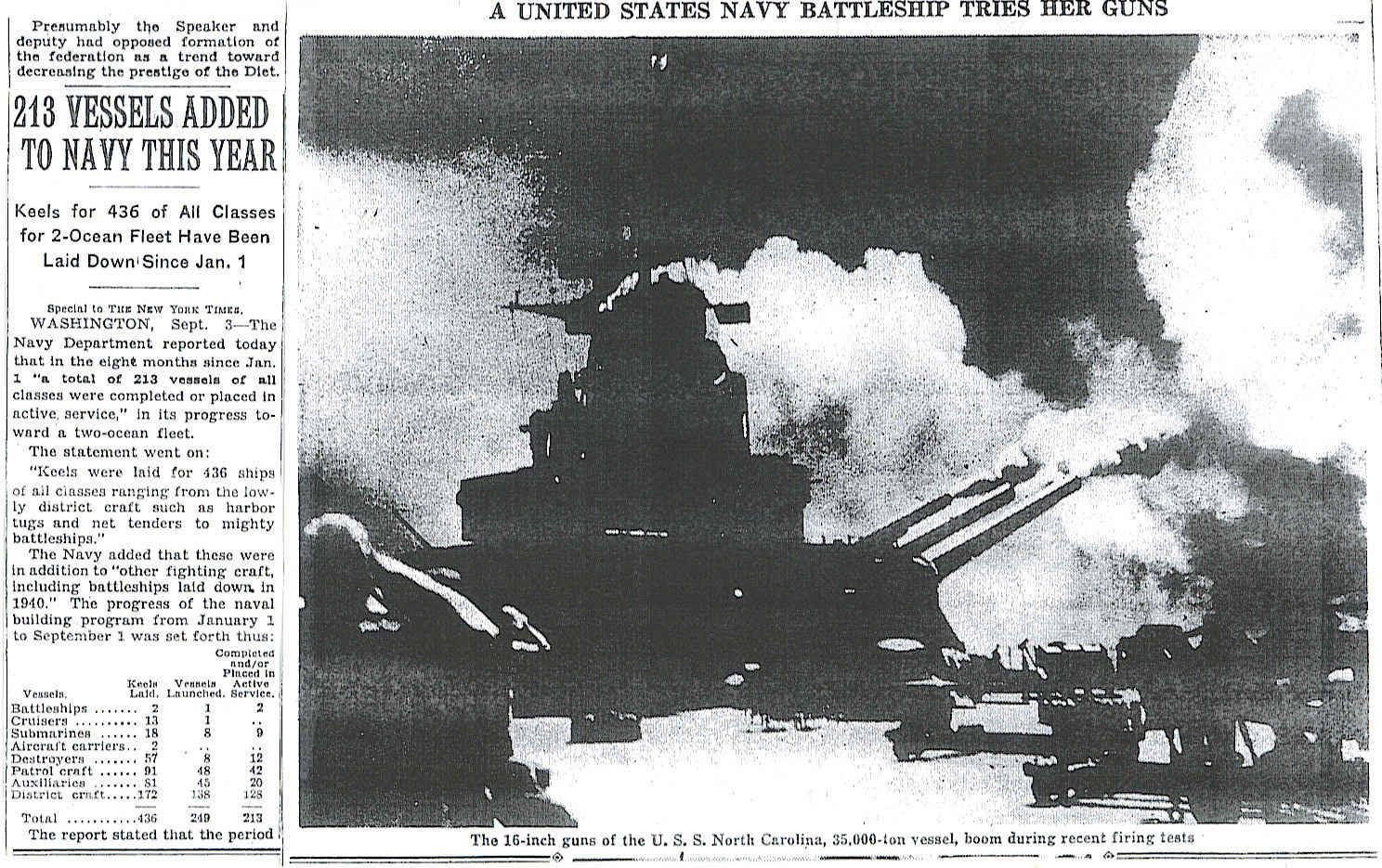
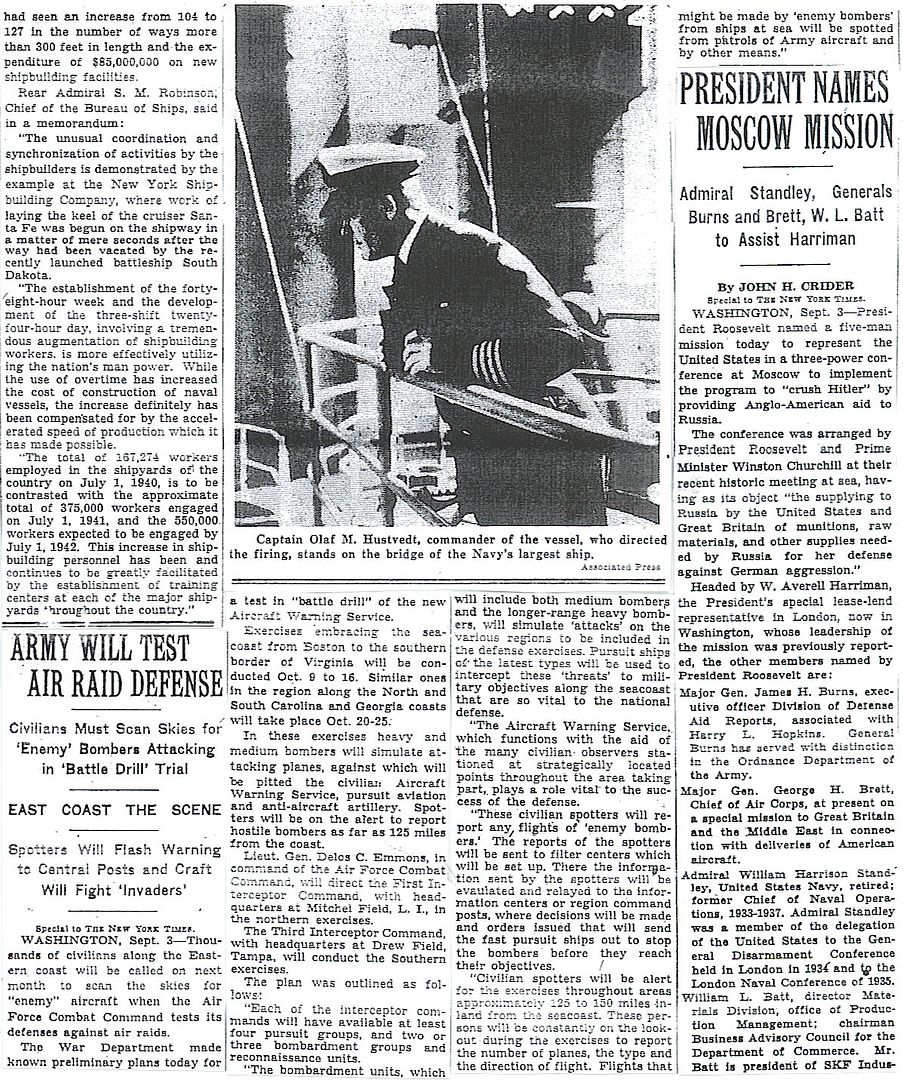

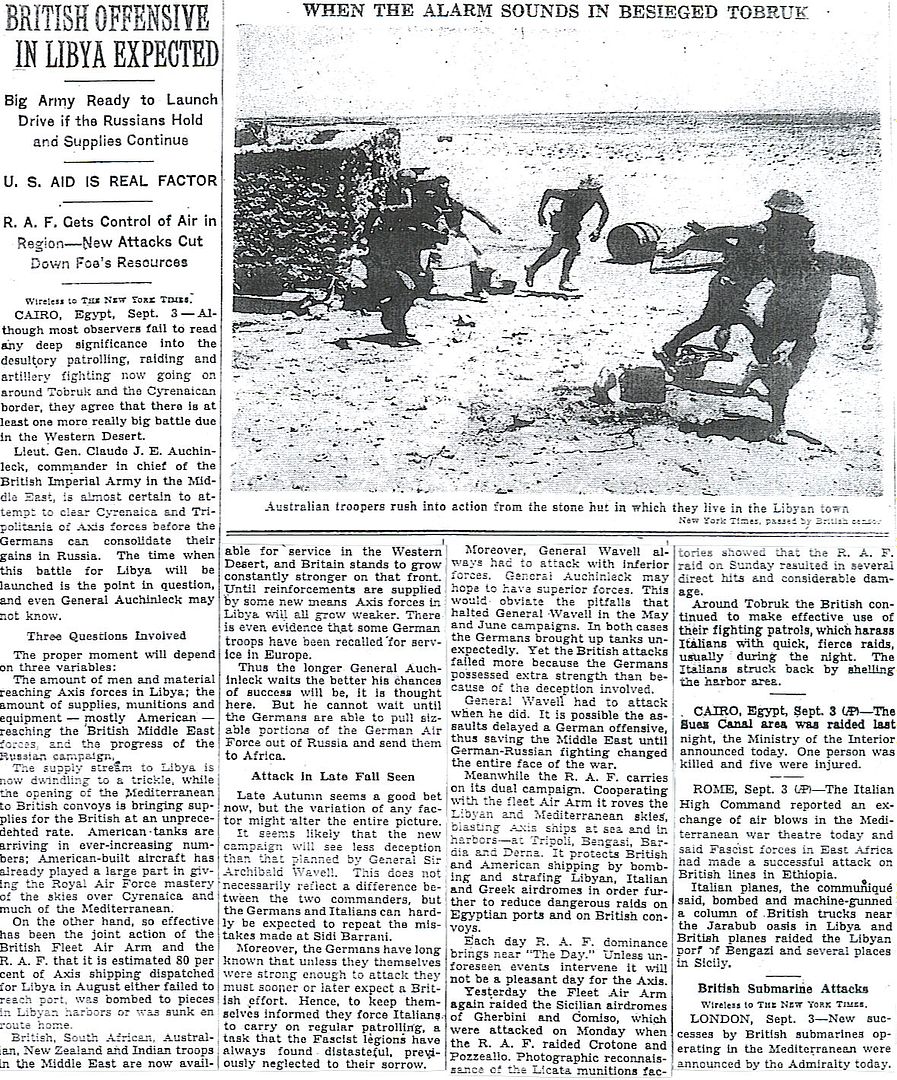
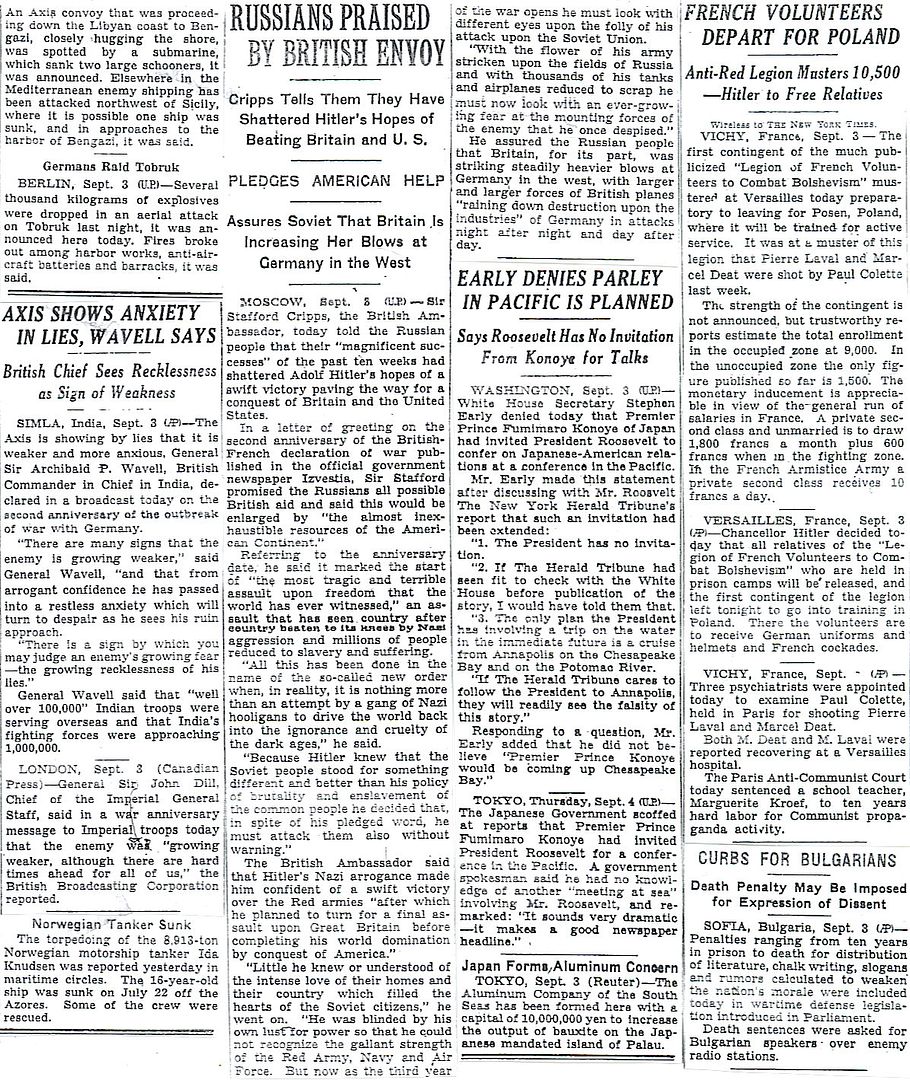
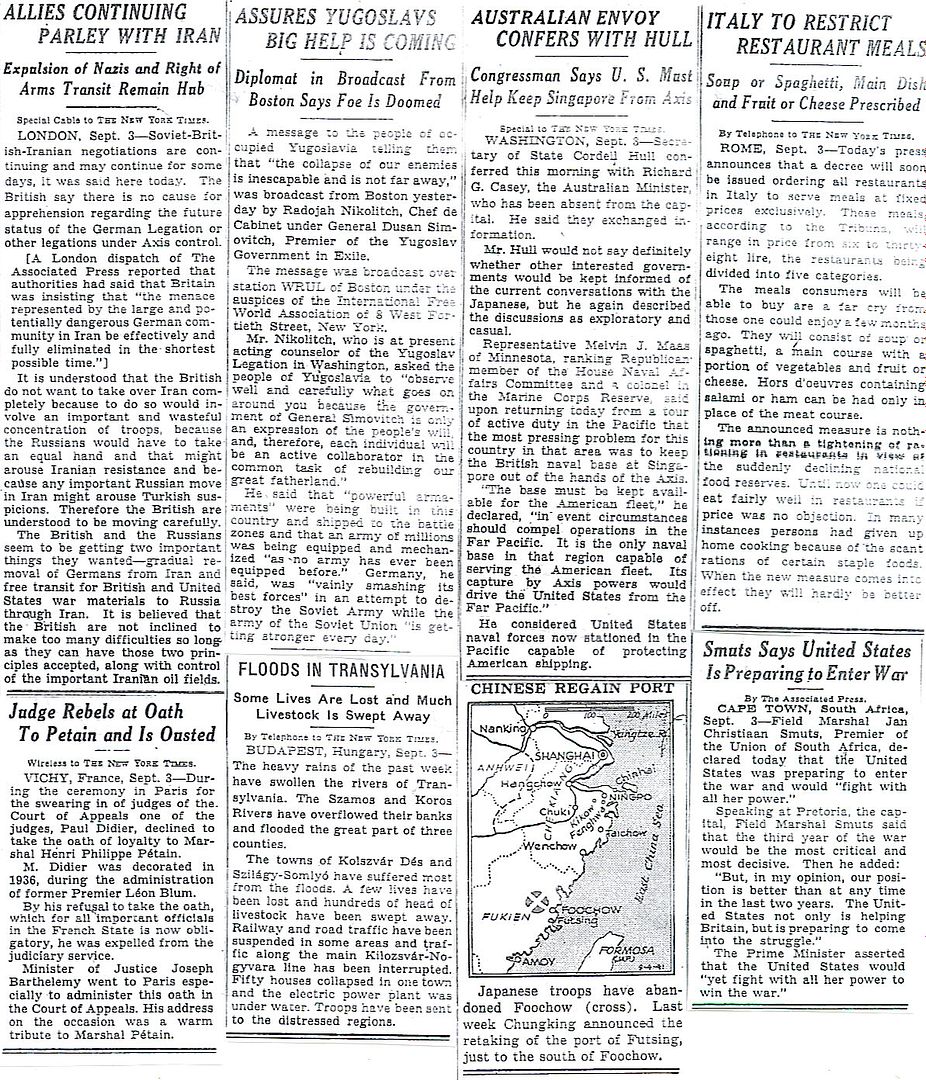
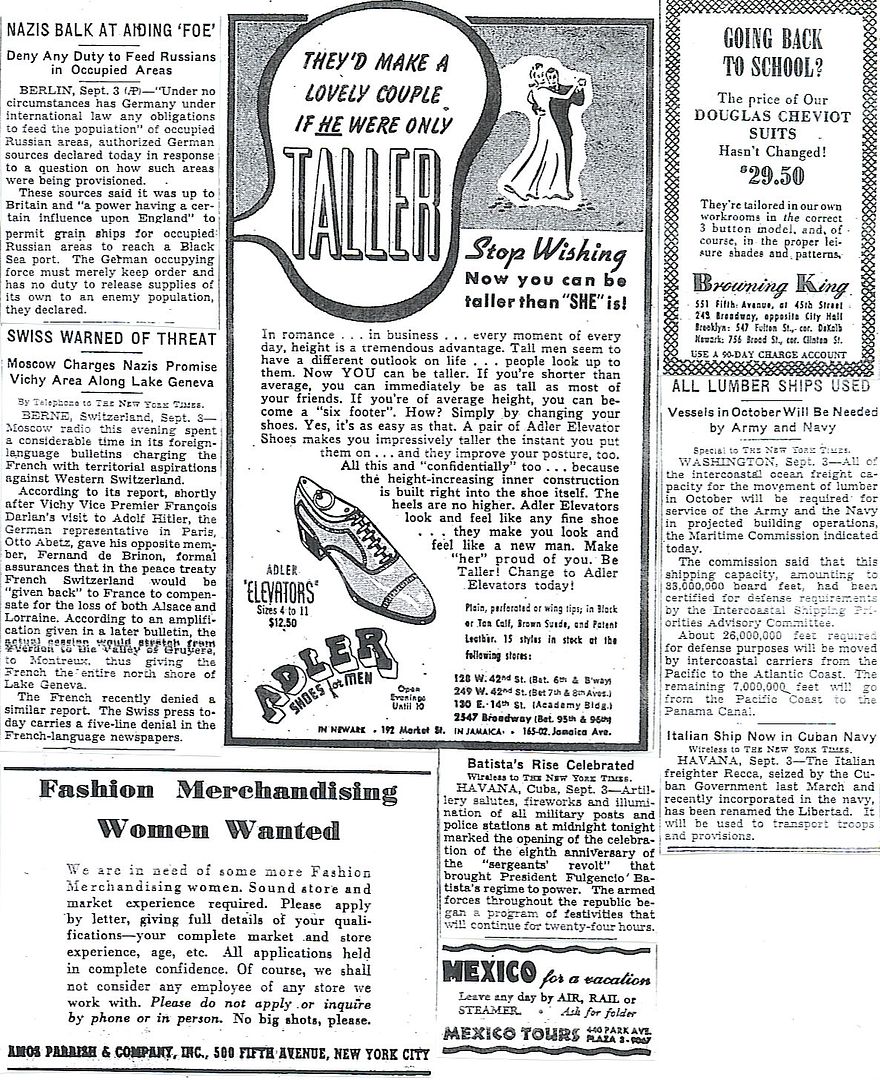
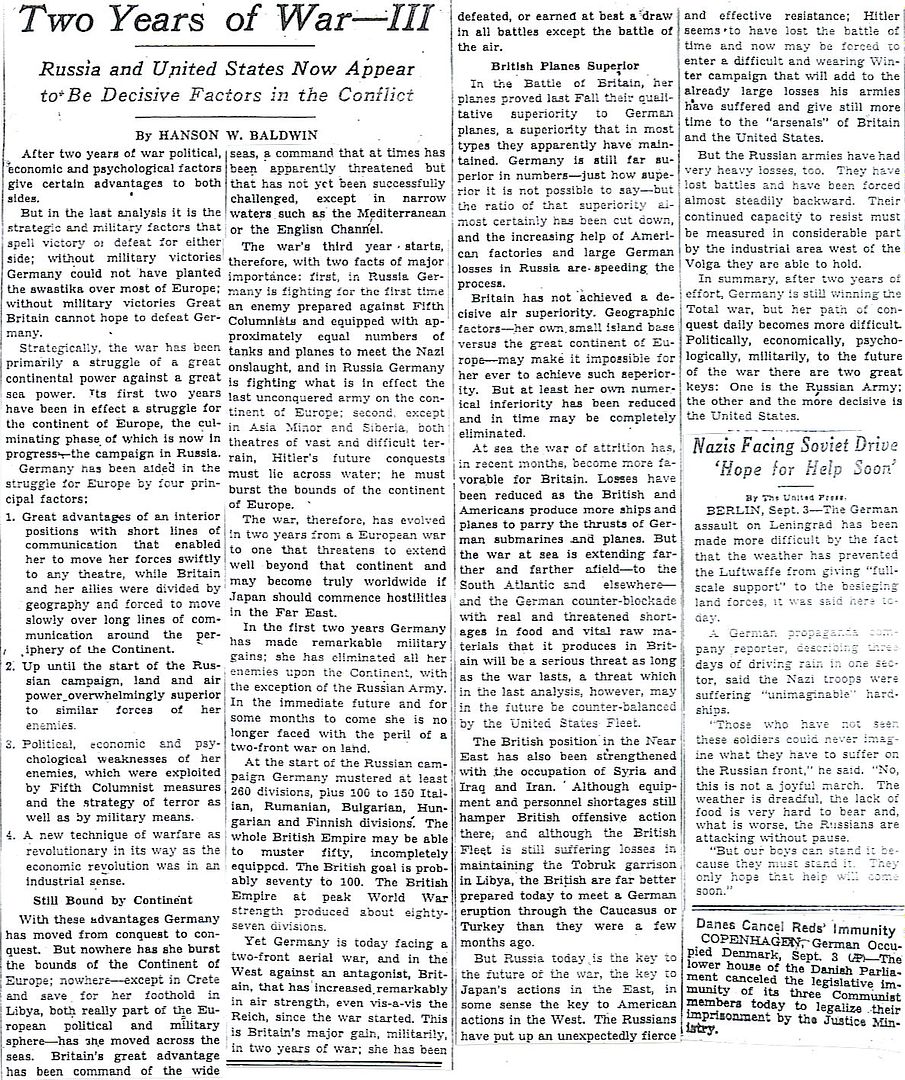
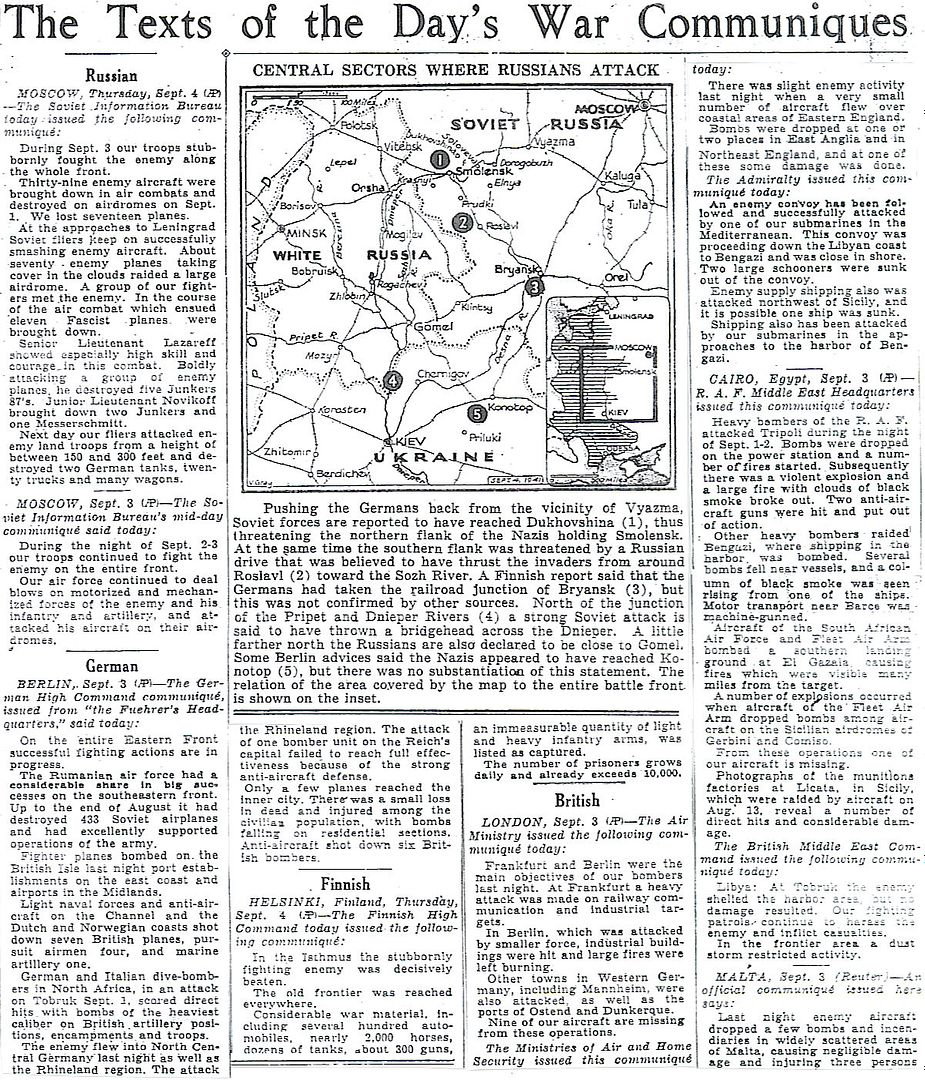
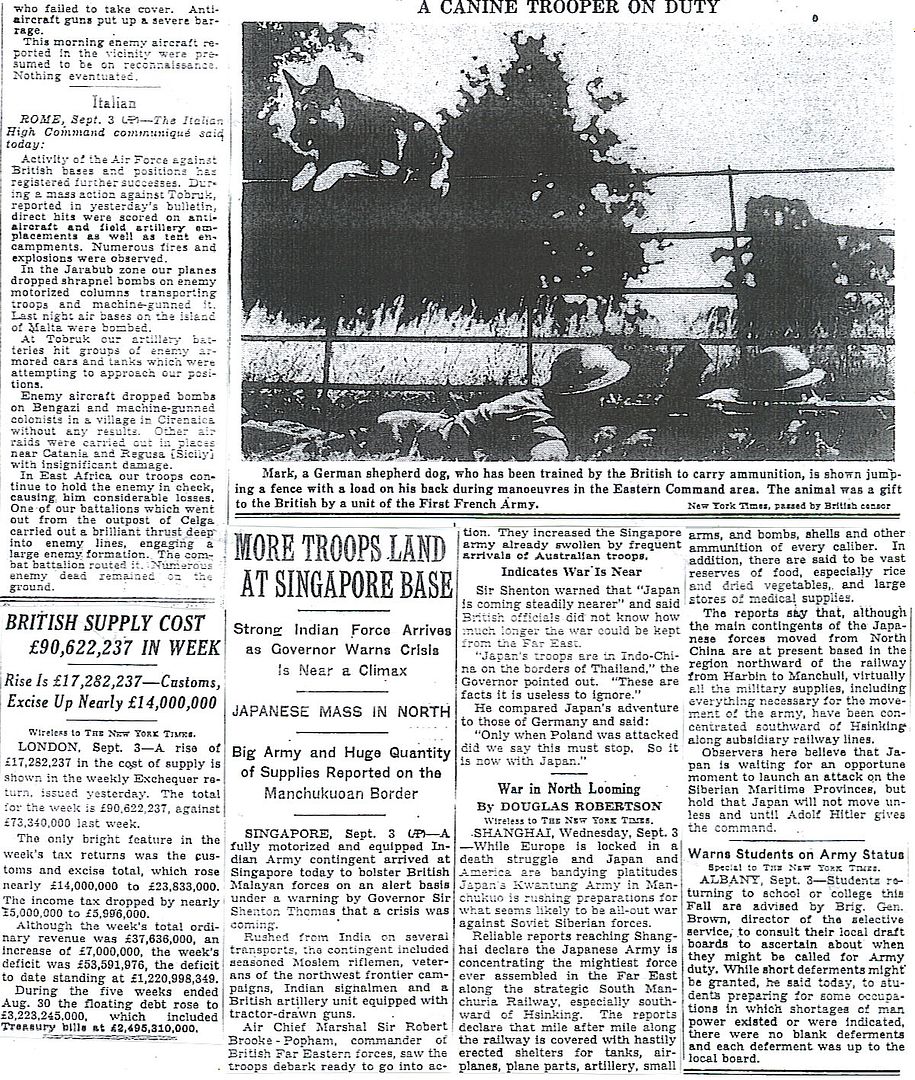
I'm pretty sure that CougarGA7 can cite chapter and verse (saving me the trouble of looking it up ;-) ), but I am certain that war with Japan was part of the joint American / British military strategy going back to at least 1940, if not before.
Early on it was decided that the war against Germany would receive first priority for US men & supplies, and that Japan would be kept on the "back burner" until after Hitler was defeated.
In the event, it turned out that the Pacific theater received a larger share of US resources that pre-war planning had imagined, because, to put it bluntly, enough Soviets were fighting and dying in the East to reduce the effort required to defeat Hitler in Western Europe.
Hence more resources available for the war on Japan.
As a person note: my Dad's 33rd Infantry Division originally trained for service in North Africa.
When that became unnecessary, the division was reassigned to the Pacific theater.
Just a small example of the Big Picture.
“... around September 1941 the Germans had reached the high water mark of their military campaigns.”
Actually, no. 1941 still has operation Typhoon on the front of AG Center, which will bring the German Army to the gates of Moscow, from which they’ll be driven in a Soviet counter-offensive starting December 6th. AG South will take [then lose] Rostov on the don in November.
In Africa, Rommel will be driven back to El Agheila in November, after Operation Crusader. BUT...
In January, 1942, Rommel will counterattack, and by August, he will be inside Egypt, at El Alamein. In Russia, the Germans will pinch off a Red Army offensive in May 1942, and riposte with the opening of Operation Blue, which will lead the German Army into the Caucasus, and the seizure of the Maikop oilfields, and to the banks of the Volga [at Stalingrad]. And Manstein will have seized the Crimea and Sevastapol.
So while the Germans were no longer capable [after 1941] of offensive operations in the USSR across the entire front, the high water mark of German military operations is at least a year off.
thanks, good response.
i see your point about gains in 1942 in russia leading to stalingrad.
i guess i was overstating the disaster in front of moscow in fall 1941 where hitler ordered his troops to stand and die. that order did, i guess, halt the retreat.
but you would have to say at that point the german plan for russia was in total shambles. the russians had shown more than three times as many divisions as the germans anticipated, had halted the moscow drive, the german equipment was worn out and shot. anyone but Hitler would of had to conclude, can not go on driving into russia in 1942. but he did, and stalingrad was the result.
btw: highest reccomendation for “in deadly combat” by gottlob biederman. astounding first hand account of the war is russia. much better, imho, than the better known “forgotten soldier.
First I want to reference you to BroJoeK's post #18 since it is the source of my response. In it he outlines some of the claims made by Robert Stinnett in his book "Day of Deciet: The Truth About FDR and Pearl Harbor". Mr. Stinnett is convinced that FDR not only knew Pearl Harbor was going to be attacked by the Japanese, but intentionally kept the personnel in Hawaii in the dark about the fact in order that Japan would succeed and allow FDR to declare war on Japan and thus getting into the war in Europe. I won't go into all the errors, omissions and misrepresentations in Stinnett's work because it would take up too much print, and quite frankly I don't have that sort of time, but I will look just at the pages in BroJoeK's post for now. There are other items on Stinnett's work I have gone over in the past and I'm sure I will have to go over more in the future as well. This is just one example that demonstrates that Stinnett's work is just not a reliable resource on the events leading up to the attack on Pearl Harbor.
From start to finish of the items quoted in post #18 are from "Day of Deceit" starting on page 122 and ending on 124.
First there was the order of battle, including a reconfiguration of the Japanese fleet, that Stinnett claims was given to Kimmel by Rochefort on September 4th and was in an official report at the end of October. There is no citation for the September 4th statement and the citation for the October report is one of Stinnett's infamous "in author's file" citations which is pretty much unobtainable, unless you have a lot of money to waste on it(I have already contacted the author on sources for this book in which I was told I could have his notes for a fee that would have worked out to be around 15 to 25 dollars per page depending on the item). Now there are two problems with Stinnett's claim that Rochefort told Kimmel of this reorganization on September 4th. First, as I said, he provides no citation to back up this claim, and the wording of what exactly Rochefort told Kimmel is vague anyhow. Second, the War Plans Department estimate on the Japanese military situation on September 17th makes no mention of this new configuration and in fact mentions the old format (PHA 14-1355). Looks like Stinnett's September 4th statement is really conjecture and not supported by any facts. As to the report on the new configuration in October, even if that report was sent to Kimmel at that time, the CAST report makes mention of the 1st Air Fleet or its possible purpose. In fact it is mostly about the units that are believed to be slated for action in the Southern Pacific which everyone expected to happen regardless (and did).
His next citation is what I call a "non-citation". This is a case where the statement made in the sentence or paragraph has nothing to do with the citation attributed to it. If you are a general reader this makes it appear as a supported statement when in reality it is nothing of the sort. To demonstrate this I think I should list both the paragraph and the citation so everyone can see the example of a non-citation.
The paragraph reads: Japan's Fast Carrier Force was concentrated in the First Air Fleet, which had been formed on April 1. This force and 30 submarines of the Sixth Fleet would be aimed at Pearl Harbor on December 7. Japan's Fourth Fleet, based at Truk, was assigned to capture Guam and Wake and prevent an American military advance through the Central Pacific.11
Now here's reference number 11 from that chapter:
During the pre-Pearl Harbor era, the Pacific Fleet was in the early stages of forming a Fast Carrier Force. In 1940, Vice Admiral Charles A. Blakely faced stiff opposition from the 'battleship admirals,' who distrusted air power. However, his concept of the fast carrier strike force was later adopted by Admiral Chester Nimitz. The Pacific War was essentially won by Navy task forces built around 16 aircraft carriers of the Essex and Independence classes supported by escort carriers call baby flattops.
The first thing that should be noticed is that this citation is not a citation at all. It is just a general comment of the formation of American task forces in World War II. It does not refer the reader to any primary or secondary source material that would support the statements in the cited sentence/paragraph. Secondly, there is nothing in this citation that supports anything in the paragraph itself. Nothing on the April 1st formation of the First Air Fleet, nothing on 30 submarines of the 6th Fleet aimed at Pearl Harbor, and nothing on the 4th Fleet being assigned to take Guam and Wake. Classic non-citation.
Finally, the last cited data point is Yamamoto's Radio Silence order of 25 November 1941. This is an often cited intercept and even if Stinnett had cited it incorrectly or vaguely, it is very easy to find. The key point on this intercept is right there in Stinnett's text itself though. It was not translated until March 18th 1946, after the war was over. In November of 1941, this intercepted message didn't tell U.S. officials or military personnel anything of any worth. This is a deceptive tactic used by Stinnett in several points in this work. He will mention a piece of information that could not have been known at the time to support his thesis. Sometimes it's like this in which he acknowledges it right in the paragraph by stating, the item was not decrypted until after the fact, but there are other cases where he represents unknowable data as if they knew it at the time. This is a piece of intellectual dishonesty on the part of the author in order to put an idea into the readers head so that they may follow him down the path to a incorrect conclusion.
From a scholarly standpoint, Stinnett's work on the attack on Pearl Harbor has the earmarks of a puff piece done by a tabloid magazine. While it makes for interesting reading, it really does not stand up to any form of serious scrutiny. This is probably a reason why the author of this book is so guarded with his actual notes. It also demonstrates a clear separation between the scholarly historian, and the popular historian. Particularly in their motivations for writing in the first place.
Wm F. Buckley, Jr wrote a great piece shortly after..entitled Castro/Matthews: "I got my job through the NY Times"..a riff on the Times' then long-running classified ad campaign slogan..
Didn’t you learn anything from Dan Rather? Just because it is fake, it doesn’t mean that it isn’t accurate.
However.
It also demonstrates a clear separation between the scholarly historian, and the popular historian. Particularly in their motivations for writing in the first place.
I beg to differ, somewhat.
Scholarly historians should be focused only on pursuit of the truth, to the extent it is attainable. In my experience they are no more likely to do so than a popular historian, perhaps less.
Academic historians are even more likely to be caught up in the trendy ideologies of their time. They may not have the same financial incentive as a popular historian, at least to the same degree, which often means they are even more focused on making a name for themselves among their peers. Nobody ever made a name for themselves by writing a book showing that the traditional interpretation of history was correct, or that the revisionist POV popular among their colleagues was incorrect.
The real problem was that though the Japanese politico would have liked to get more serious about making concessions to the U.S. in order to avert a conflict, they were not really the primary player in charge. Had the Japanese cabinet suggested a withdrawal from China or even Indochina in order to preserve the peace, the militant leadership of Japan would have refused to support it and would have caused the collapse of said cabinet. The Japanese military powers to be will actually cause the political cabinet to collapse several times throughout the history of the war dating back, for the Japanese, to late 1937.
So in short, even if Hull was willing to entertain these feelers by the Japanese, it most likely would not have changed anything overall.
The booklet was small, only a little larger than an index card, and about forty or fifty pages long. The cover was a thick, canvas-like material and was dark blue in color. It was stamped "Top Secret" on the cover and the first page.
The booklet contained the Office of Naval Intelligence's analysis of the attack, the methods used, and their conclusion of what forces were used. They believed that the attack had been carried out by three, maybe four, aircraft carriers. They thought that the Akagi had been undergoing a modernization at the time and might not have been available and that the Shokaku and Zuikaku were not yet ready for combat operations (they had been rushed through the final steps of being fitted out and were commissioned on August 8 and September 25, respectively).
Now it is possible that some ONI personnel knew exactly which ships were part of the Pearl Harbor raid due to post-attack MAGIC intercepts, but this published report did not have those details, nor did it give a hint to them.
I definitely would not say before 1940 and would have to mark the beginning of 1941 as the point that any joint British/American planning took hold.
I mean, obviously there is a history on the possibility of war between Japan and the U.S. dating back to the end of World War I and Japan's endowment of the German possessions in the Pacific. These islands in the Marshall's lay in between the commerce routes for the U.S. and it's Philippine possession, and of course Guam was stuck right in the middle of it all. Ergo we have the Orange Plans which will continue to evolve during the 20s and 30s and will be ignored by MacArthur exasperating the situation on the Philippines come the end of 1941 (and for which he should have been relieved of command).
But at the same time, Orange Plans had no bearing on any joint American/British policy. In fact quite the opposite. Even into the late 30s there were variations of an Orange-Red Plan which planned around the possibility that the United States would be at war with Britain and Japan at the same time. It was not until Britain was at war with the Nazis that War Plan Red (war with Britain) and its derivatives were finally put to bed and the United States gravitated to the British cause against the Axis.
The United States had already begun looking at the Axis problem before this with the commission of the Rainbow Plans in April 1939 but this was independent from any planning with the British. In fact, of the first four Rainbow plans, only one of them, Rainbow 4, had Britain listed as an ally to the American cause. Rainbow 4 called for full support of Britain and France against Germany and Italy. With this plan it would also suggest that America cover the Pacific since it was assumed that the British and French could cover the Atlantic. A derivative of Rainbow 4 was developed later and designated Rainbow 2. Rainbow 2 called for America to concentrate its offensive activities to the Pacific while Rainbow 4 (Now called Rainbow 5 with the insertion of the new Rainbow 2) called for a defensive posture in the Pacific while resources were dedicated to the defeat of Germany/Italy. This was the final plan that was accepted by early 1941.
Before that though, the Joint Board and the Joint Planning Committee focused their efforts on Rainbow 1 which called for the unilateral defense of North America above 10 degrees north latitude.
Certainly there are always exceptions to the rule, but as you say, the scholarly historian should be focused on the attainment of truth (as close as can be achieved) and in my readings most of them are.
That doesn’t mean that all scholarly historian fit that mold, or that all popular historians do not. Rich Atkinson has written some very well researched works and he is not a historian. The point though is that an academic historian could not make a positive name for themself with their peers if the work had this level of academic scholarship.
I would imagine that MAGIC decrypts at the time didn’t add much to the ONI’s knowledge base. At this point MAGIC is mostly just PURPLE diplomatic messages which would not given much information on ship dispositions.
In the spring of 1943, the Japanese were running monthly supply convoys to Attu and Kiska, usually two or three freighters escorted by a handful of destroyers. On the morning of March 27, a task force composed of one heavy and one light cruiser and four destroyers attempted to ambush this force but were instead ambushed themselves when they discovered that the Japanese had sent two heavy and two light cruisers up to provide support for the convoy escorts.
In what became known as the Battle of the Komandorski Islands, the US and Japanese Navies slugged it out for almost four hours in the last daytime gunnery duel in naval history that did not involve aircraft. Toward the end of the battle, not realizing that he'd crippled the American heavy cruiser (Salt Lake City) and one of the destroyers (Bailey), Admiral Hosogaya fears the arrival of American reinforcements and orders a full retreat. For his actions, he is relieved of command and forced into retirement.
On a personal note, the main reason I know so much about this battle is the commander of the Bailey was my grandmother's cousin, Lt. Commander John Atkeson. He received the Navy Cross for his actions in this engagement.
That's pretty cool, your relation to the Battle of Komandorski. The two heavy cruisers the Japanese brought to the islands were the Nachi and the Maya. The Salt Lake City in that battle hit the Nachi several times but was damaged by the shock of its own guns when the gunfire caused damage to the hydraulic steering system making the ship very difficult to steer. Then the ship received a hit from the Japanese causing it to list 5 degrees to port. A mistake by the damage control team caused the ship to lose power and she went dead in the water.
Rear Admiral Charles H. McMorris then ordered the destroyers in the flotilla to commence a torpedo attack on the Japanese ships. As you said though, Vice Admiral Hosagaya broke off the engagement before they could get into range which cost him his career being relegated to the naval reserve.
That's all I know about that battle, if you have any additional stories you heard in your family I'd be interested to hear them.
The second thing was Salt Lake City began running out of armor-piercing rounds and had to switch over to shore bombardment rounds. These shells had different colored marking dye and they exploded as soon as they hit the water, convincing Hosogaya that he was being attacked by American bombers hiding up in the clouds. He was already jumpy about US airpower, having witnessed its devastation at Midway, so now he took council with his fears and ran for home.
Thanks for the ping. I dont buy into the “FDR knew” stuff either.
When I first heard about it, I found it interesting, but through my own reading, dismissed it.
I’ll tell you, I wish it was true. I’m not fan of FDR. His kowtowing to the Soviets caused the enslavement of all of Eastern Europe for almost 50 years. His economic policies were terrible and some of those decisions we are still paying for today. If there was any real evidence of malfeasance on the part of FDR I’d be the first to be shouting it from the rooftops. What I’ve found instead is that there is a whole litany of mistakes across the entire chain of command along with the procedural defects in how we handled intelligence and how we coordinated between the services that left us open to just such an attack.
Disclaimer: Opinions posted on Free Republic are those of the individual posters and do not necessarily represent the opinion of Free Republic or its management. All materials posted herein are protected by copyright law and the exemption for fair use of copyrighted works.